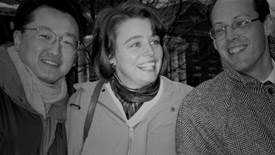Navajo Nation Hosts Pioneering Cancer Talks
Posted on Jun 3, 2015
Of the dozens of cancer symposia held around the world in April, none resembled The Navajo Cancer Survivorship Conference, a gathering of some 70 doctors, patients, traditional healers, nurses, community health workers, and residents at the Navajo Nation Museum in Window Rock, NM, on April 16. The goal of the conference wasn’t to tout cutting-edge advances or experimental drugs, as so many do. It was to figure out how existing cancer care can better serve patients in and around the Navajo Nation, a 27,000-square-mile tribal area in the Southwest.
The Dana-Farber Cancer Institute and Chevron Corporation, among others, helped cover expenses. The Navajo Nation Department of Health, cancer patients, health-care providers, and non-profits, including the Gallup, NM-based Partners In Health sister organization Community Outreach and Patient Empowerment (COPE), set the agenda. Former Navajo Nation Vice President Rex Lee Jim sat in, as did Partners In Health CEO Dr. Gary Gottlieb.
At issue were two galling facts: First, there is no cancer care available within the Navajo Nation, the largest tribal area in the U.S. And second, American Indians have the lowest cancer survival rates of any racial group in the U.S. Overall, 52 out of 100 American Indians survive for five years after being diagnosed with cancer, compared to 58 out of 100 non-Hispanic whites, according to the National Cancer Institute. The conference aimed to tease out some of the reasons for that disparity, and brainstorm how cooperation and collaboration could improve care.
It was a busy day. The director of the Navajo Nation Epidemiology Center shared what’s known about cancer prevalence and inequitable cancer deaths in Navajo. (Deaths from lung and breast cancer are extremely low compared to whites; the opposite holds true for stomach cancer.) A traditional healer talked about how Navajo medicine, such as local herbs and ceremonies, have long cared for and treated patients. Survivors and their loved ones shared personal stories, in part to support each other, in part to illuminate the challenges to providing top-notch care. To reach the nearest clinic offering chemotherapy treatments, one attendee explained that she had to drive for four hours. And it wasn’t like a road trip from New York to Boston. Traveling out of the Navajo Nation is often a huge challenge; transportation and lodging expenses fall to patients and 44 percent of the Navajo Nation's population lives below the poverty line.
Attendees highlighted the need for better access to hospice care and oncology units, improved clinician-patient communication, and patient advisory committees. But maybe best of all, another small step was taken toward self-determination. Navajo people, not outside researchers, led the discussions about improving cancer care in the Navajo Nation.

